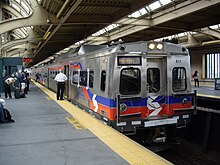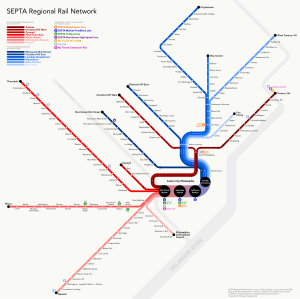
Back Ferrocarril Regional SEPTA Spanish Réseau régional de la SEPTA French SEPTA Regional Rail Italian SEPTA 리저널 레일 Korean SEPTA Regional Rail SIMPLE
| SEPTA Regional Rail | |||
|---|---|---|---|
 | |||
 A SEPTA Regional Rail train at 30th Street Station in Philadelphia | |||
| Overview | |||
| Owner | SEPTA | ||
| Area served | Delaware Valley | ||
| Transit type | Commuter rail | ||
| Number of lines | 13 | ||
| Number of stations | 155[1] | ||
| Daily ridership | 78,000 (weekdays, Q2 2024)[2] | ||
| Annual ridership | 17,910,709 (FY 2023)[3] | ||
| Headquarters | 1234 Market Street Philadelphia, Pennsylvania 19107 | ||
| Website | septa | ||
| Operation | |||
| Began operation | Assumed operations in 1976, officially established 1983 | ||
| Reporting marks | SEPA, SPAX | ||
| Infrastructure manager(s) | |||
| Number of vehicles | 404 revenue vehicles as of 2015[update][4] | ||
| Technical | |||
| System length | Total: 280 mi (450 km)[4]
| ||
| Track gauge | 4 ft 8+1⁄2 in (1,435 mm) standard gauge | ||
| Electrification | Overhead line, 12 kV 25 Hz AC: Amtrak's 25 Hz traction power system SEPTA's 25 Hz traction power system | ||
| |||
The SEPTA Regional Rail system (reporting marks SEPA, SPAX) is a commuter rail network owned by SEPTA and serving the Philadelphia metropolitan area. The system has 13 branches and more than 150 active stations in Philadelphia, Pennsylvania, its suburbs and satellite towns and cities. It is the sixth-busiest commuter railroad in the United States. In 2016, the Regional Rail system had an average of 132,000 daily riders [5] and 118,800 daily riders as of 2019.[1]
The core of the Regional Rail system is the Center City Commuter Connection, a tunnel linking three Center City stations: the above-ground upper level of 30th Street Station, the underground Suburban Station, and Jefferson Station. All trains stop at these Center City stations; most also stop at Temple University station on the campus of Temple University in North Philadelphia. Operations are handled by the SEPTA Railroad Division.[6]
Of the 13 branches, six were originally owned and operated by the Pennsylvania Railroad (PRR) (later Penn Central), six by the Reading Company, while one was constructed under SEPTA in 1985. The PRR lines terminated at Suburban Station; the Reading lines at Reading Terminal. The Center City Commuter Connection opened in November 1984 to unite the two systems, turning the two terminal stations into through-stations. Reading Terminal was replaced by the newly built underground Market East Station (now Jefferson Station). Most inbound trains from one line continue on as outbound trains on another line. Some trains, including all trains on the Cynwyd Line, terminate on one of the stub-end tracks at Suburban Station. Service on most lines operates from 5:30 a.m. to midnight.
- ^ a b "SEPTA OPERATING FACTS, FY 2019" (PDF). Retrieved 2022-06-27.
- ^ "Transit Ridership Report Second Quarter 2024" (PDF). American Public Transportation Association. September 3, 2024. Retrieved September 5, 2024.
- ^ "Route Operating Statistics". Retrieved March 22, 2024.
- ^ a b "SEPTA OPERATING FACTS, FY 2015" (PDF). Archived from the original (PDF) on 2015-10-07. Retrieved 2016-07-16.
- ^ "Revenue & Ridership Performance, February FY2016" (PDF). Archived (PDF) from the original on 2016-04-07. Retrieved 2016-03-16.
- ^ 2008 SEPTA Railroad Division employee timetable Archived 2011-12-09 at the Wayback Machine accessed August 16, 2011
